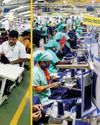The handicraft sector is an important segment of the Indian economy and generates sizeable employment as well.

The rural economy holds noteworthy significance in Indian economy and the handicraft sector accounts for an important share of the country’s export market. The total handicraft industry spans different regions and involves thousands of artisans. According to industry sources, there are more than 60,000 export houses dealing with handicrafts in India. Almost all Indian states have their own set of signature handicrafts that reflect the cultural and traditional ethos of that state. However, the sector has its set of problems as well. Low availability of technical support is a significant drawback though some advancement has been made and efforts are on to bridge the gap between demand and supply.
Ashok Majhi, a Dokra artist from Bardhaman, West Bengal, told BE, “The condition is not very bad right now since the government is actually promoting our work through different emporiums and ensuring better exposure of our work.”
Total export of handicrafts from India grew by 11.07% to reach $3.66 billion in FY 2016-17. During the FY 201718, the handicraft market raised an approximate amount of $3,555 million and shawls, textiles, and scarves performed well. Agarbatis and attars ranged at around $149.82 million and embroidered and crocheted goods were valued at around $506.17 million. Handicrafts and textiles are exported to different countries like the US, the UK, the UAE, and Germany among others and the Export Promotion Council for Handicrafts (EPCH) is the government body operating under the Ministry of Textiles, Government of India, which is responsible for promotion of the handicraft sector.
Geographically Specific Handicrafts
Handicrafts are handmade crafts or art which cannot be produced mechanically. Considering India’s diversity, every region has something specific to showcase from every nook and corner. Let us look into what different regions of India have to offer:
Denne historien er fra August 1 - 15, 2018-utgaven av BUSINESS ECONOMICS.
Start din 7-dagers gratis prøveperiode på Magzter GOLD for å få tilgang til tusenvis av utvalgte premiumhistorier og 9000+ magasiner og aviser.
Allerede abonnent ? Logg på
Denne historien er fra August 1 - 15, 2018-utgaven av BUSINESS ECONOMICS.
Start din 7-dagers gratis prøveperiode på Magzter GOLD for å få tilgang til tusenvis av utvalgte premiumhistorier og 9000+ magasiner og aviser.
Allerede abonnent? Logg på

Bank of Baroda, Kolkata Zone organised Mega Kisan Melas in West Bengal
Bank of Baroda (BOB) organised Mega Kisan Mela at Konkalitala in Birbhum District of West Bengal on November 18, 2024 as a part of the 7th Edition of the Baroda Kisan Pakhwada (BKP).

Time-Bound Disposal of Cases to Expedite the Delivery of Justice and affordabe by all in India
The delay in the disposal of cases in Indian courts remains a significant hurdle to the nation's progress.

Dev Deepawali: A grand celebration of light, spirituality, and culture in Varanasi
The holy city of Varanasi, often regarded as India's spiritual and cultural heart, came alive with the splendor of Dev Deepawali on the sacred day of Kartik Purnima.

The life of Job 'Ye judge not the judgment of God' - Jesus Christ
The Holy Bible reveals through the life of Job how the Lord tests the righteous and that faith helps one to overcome life's adversities.

India has the highest potential for the garment industry, only a conducive government policy is required.
India's textile industry is poised for remarkable growth, with expectations to double its contribution to the GDP within the next six to seven years.

Global Public Debt may be worse than it appears, warns IMF
Global Public Debt Set to Exceed $100 Trillion, Warns IMF

The economic consequences of Trump's Presidency: A global perspective
One of the key economic factors contributing to the Democrats' loss in the US elections was the significant rise in inflation, which was initially triggered by the COVID-19 pandemic and exacerbated by the Russia-Ukraine war.

Challenges and Successes in West Bengal's Education Sector: A Comprehensive Overview
The education system in West Bengal, particularly in districts, villages, slums, and government institutions, reflects a blend of progress and ongoing challenges.

What India can expect from Trump's return
I may be too early to predict how Donald Trump's second term as president will impact the global oil market.

Stocks Surge Following Donald Trump's Election as 47th President of the USA
Stocks soared following the election of Donald Trump as the 47th President of the United States. Investors anticipated that the Information Technology (IT) sector would benefit from lower corporate taxes under the Republican regime, with IT stocks leading the rally.